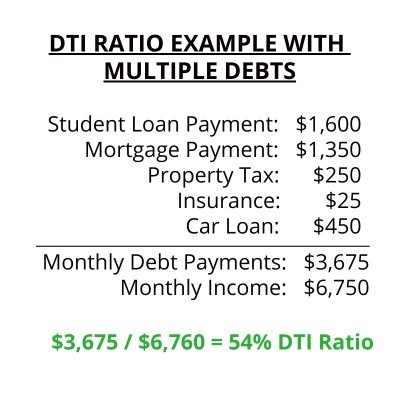The dream of many is buying a house. This is also one of the most popular ways people build wealth. That is becoming more and more of a dream for those trying to buys a house with student loans.
From a high level, the process of buying a house is:
- Deciding if you should rent or buy;
- Determining how much you can afford vs what you qualify for; and
- If buying, how many points you should pay on a mortgage.
This article focuses on #2 above. Specifically, we will be discussing buying a house with student loan debt.
If you have student loans and are planning to buy a house, in the process, or have been denied a mortgage then this article is for you.
Table of Contents
Why Its Hard To Get Help & Where To Get It
Big Box lenders and their employees often times make it really hard to get a loan. By “Big Box” I’m referring to lenders such as Bank Of America, Wells Fargo, etc…
Its hard to get a mortgage with these companies when you have student loans because these businesses process hundreds of thousands, if not millions of applications per year.
They have cookie cutter models to determine if you qualify for a loan or not Simply put, they collect your data, plug it into a software, and an answer is spit out.
When you get declined its hard for you to figure out how to get approved because:
- The employees are so busy processing applications they just want to move on to the next borrower (i.e. the “low hanging fruit” that is easy to get qualified); and
- they aren’t trained on things like student loans.
Therefore, they have no way of trying to help you manipulate the data to qualify.
The solution is to find a lender that knows what they are doing. For example, FitBUX partners with Neo Home Loans and Movement Mortgage to provide our members loans when they are buying a house. They know the process inside and out. Especially if you have student loans.
You can use lenders such as these or try to find other lenders to shop with. Either way, I’d avoid the big box lenders.
High Student Debt and Buying A House: The Major Problem
Buying a house with student loans is difficult for obvious reason. Adding another debt to your budget reduces your monthly cash flow.
According to CNBC, 83% of people ages 22-35 who haven’t bought a home blame their student loans.
Many have tried to buy a house but don’t know why they are denied.
There are three primary items that determine qualifications for a home loan:
- Credit (your FICO Score),
- LTV ratio (Loan-To-Value or how much loan you apply for relative to the value of the house), and
- Your DTI ratio (Debt-To-Income)
The primary reason we see most denied when buying a house is their debt-to-income ratio (DTI).
Below is an example of why that is. Later in the article I explain a way to potentially help you qualify for a mortgage by “optimizing” your DTI ratio.
First things first though. What is DTI?
It is your total debt obligation divided by total gross earnings. By total we mean all monthly payments on all debt. This includes student loans, auto loans, credit cards, etc…
When you are buying a house, the lender includes the mortgage payment, property tax, home owners insurance and HOAs into this calculation.
To qualify your DTI ratio can not be more than 45% – 55%. Most of the time you have to have a DTI ratio lower than this. For example, conforming loan limits require 43% or less.
Below is an example that illustrates the DTI calculation.
A Grad School Example
An individual with a graduate degree used to be an automatic to qualify for and buy a house. However, that has changed due to student loans.
For the following example, we will use actual data from a FitBUX member that recently used our financial planning technology.
They were a recent graduate making $70,000 a year (i.e. $5,833/months). The graduate has $145,000 in student debt. Their monthly required payment under the standard 10 year student loan repayment plan $1,632.
She has no other debt or source of income. Her DTI ratio would then be 28% ($1,632/$5,833). Let’s say she wants to buy the house of her dreams. We’ll assume lenders will not let our new graduate have a DTI ratio greater than 45%.
This means that her monthly payment, taxes, homeowners insurance, PMI, and HOA fees must be 17% of her income or less. (45%-28%= 17%) Let’s assume that she would use the full 17% just for her mortgage.
Thus, 17% of her $70,000 salary is $11,900 per year. Therefore, the max her monthly payment can be is $991 per month. Assuming a 30-year mortgage (Principal and Interest) at 5%, she would only qualify for a mortgage of $185,000.
Once you account for property taxes and homeowners insurance, that number will be even less of course.
One big item to note, that is what she qualifies for. How much house she can afford is even less!

Not All Student Loan Repayment Plans Are Treated Equal
Above I mention that Big Box Lenders aren’t trained to help those buying a house with student loans.
Many brokers and lenders are not either which is why it may take you time to find one.
This is important because not all student loan plans are treated equally when you are trying to qualify for a mortgage.
To simplify student loan plans at FitBUX, our student loan planners break them down into two strategies:
- Pay Off Strategies, and
- Loan Forgiveness Strategies.
It is extremely important to know the differences between the two because they will greatly influence your DTI ratio. In the next sections I will break down how to qualify for a mortgage for both strategies.
I want to note again why its so important to find a lender that knows how to work with these strategies. That is the primary reason why we partnered with Neo Home Loans and Movement Mortgage. They are two of the few lenders that we found that are licensed nationwide that actually know this stuff!
Buying A House When Using A Pay Off Strategy For Your Student Loans
You may “feel” that you can afford more house. Unfortunately, your lender won’t take your “feelings” into consideration. All they care about is what the “numbers” are.
Therefore, let’s figure out how to manipulate your “numbers” so buying a house with student loans is easier.
One way to make your “numbers” look better is to reduce your required monthly payment on your student loan.
You can do this by using the extended standard repayment plan on your Federal loans. Taking the above actions will decrease your required monthly payment since you’ll be paying off your loans over a longer period of time.
Note: Using The extended standard repayment plan for Federal Loans would give you the same interest rate.
Effect Of Extending Your Loans
Using the same example in the previous section, extending all loans to 25 years while keeping the same interest rate would reduce the total required payment from $1,632 down to $962.
The new DTI ratio would then be 16% ($962/$5,833), with 29% available to secure a mortgage.
All else being equal, our recent graduate would now qualify for a mortgage of $315,000.
One extra thing you can do is refinance your high interest rate loans into a 20 year private loan to save money and drop your required payment further. If you have private loans, you can try refinancing them into a longer term (If you need help refinancing your student loans, check our our free student loan refinance service).
In short, the more you reduce your required monthly payment on your student loans, the easier it is to qualify for a mortgage and the more you can qualify for!

Bad News, Good news
One thing to keep in mind when considering extending loans is you could end up making payments for a long-time. Therefore, you end up repaying a lot more overall due to the longer term.
That’s the bad news. To neutralize this, it is important to build a strategy where you will make additional prepayments. This will help you repay your loans faster and pay less interest.
Buying A House When Using A Loan Forgiveness Strategy For Your Student Loans
The biggest problems for those buying a house with student loans comes from those that are pursuing a loan fogiveness strategy.
First things first, the government classifies income-based repayment plans (IBR), pay as you earn (PAYE), revised pay as you earn (REPAYE), and public service loan forgiveness (PSLF) as loan forgiveness plans. Therefore, these are the strategies I’ll be discussing in this section. There are a few keys you need to know before dive deeper:
- You must know how Income-Driven Repayment plans work.
- The following discussion is about Fannie Mae, Freddie Mac, and FHA loans.
- The official language for mortgage qualifications refer to these as “Non-amortizing” student loans. This is key as it is different than “deferment” and “forbearance” (I discuss in detail below).
Your required payment on a student loan forgiveness strategy is based as percentage of your income. This required payment is then reported to the credit bureaus and is used in the DTI calculation for your mortgage qualification…. sometimes.
One more item to note: These are guidelines put forth by the FHA, Fannie Mae, etc… Lenders still have the right to use their own calculations to qualify you. Therefore, just because one lender denies you doesn’t mean others will as well.
FHA Guidelines
As of June 2021, FHA loans use the actual payment on your credit report. Previously, they would assume your monthly payment is 1% of your loan balance.
For example, if I have a $300 monthly payment but my loan balance is $140,000, then for the purpose of my DTI calculation for the mortgage, the lender will use $1,400 as an assumed monthly payment.
The result is that I qualify for about $170,000 less in a mortgage than I would have if they used my actual payment.
As of June 2021, you can use your actual payment. For example, now they will use my $300 required payment and I would qualify for a $300,000 mortgage.
Under the old calculation they would’ve used $1,400 instead, which means I would only qualify for a mortgage of $130,000!
If your payment is $0 per month, then the lender uses half a percent (0.5%) of the student loan balance as an estimated monthly payment.
One caveat to this. If your payment is $0.00 a month, they still use .5% of the balance of your student loans. For example, if you have $200k in student loans, the lender will assume your required monthly payment is $1,000 a month on your student loans..
One last item for FHA loans, YOU HAVE TO BE IN REPAYMENT. If your loans are in forbearance, there is a zero dollar payment on your credit report. In this situation, FHA will use .5% of your student loan balance to estimate a required monthly payment on your student loans.
Fannie Mae & Freddie Mac Guidelines
For Fannie Mae and Freddie Mac, the required payment for your student loans is always used in the DTI calculation for your mortgage. This means if your student loan payment is $300 per month, they use that amount for the DTI calculation.
However, there is one caveat.
Many people have a $0 required payment for their student loans because they just graduated, forbearance, or because of COVID.
You have to differentiate between a $0 required payment and deferment/forbearance. If you have a $0 monthly required payment, then for Fannie Mae and Freddie Mac mortgages, the $0 payment will be used in the DTI ratio.
When you are in deferment (such as being in your grace period) or in forbearance, you also have $0 due each month. HOWEVER, THIS IS DIFFERENT THAN HAVING A $0 REQUIRED PAYMENT.
Since you are in deferment or forbearance, Fannie Mae will take 1% of your student loan balance and Freddie Mac will take 0.50% of your loan balance and assume that is your required monthly payment.
For example, if your loan balance is $140,000 then your assumed monthly payment for the DTI calculation will be $700. The easy solution for people would be to apply for a Fannie Mae and Freddie Mac loan. However, its not that simple. These mortgage programs require much higher down payments than the FHA loan program.
Conclusion
To sum it up, if you are using a pay off strategy for your student loans, buying a house is more straight forward. Try to reduce your required payment and it will be easier to qualify. If you are on a loan forgiveness student loan strategy, there is more leg work you have to do in order to qualify.
This article was written by Joseph Reinke, CFA, CEO of FitBUX

